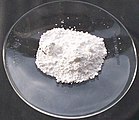Lead (II) sulfate
| Structural formula | |||||||||||||||||||
|---|---|---|---|---|---|---|---|---|---|---|---|---|---|---|---|---|---|---|---|

|
|||||||||||||||||||
| General | |||||||||||||||||||
| Surname | Lead (II) sulfate | ||||||||||||||||||
| other names |
|
||||||||||||||||||
| Molecular formula | PbSO 4 | ||||||||||||||||||
| Brief description |
white crystalline solid |
||||||||||||||||||
| External identifiers / databases | |||||||||||||||||||
|
|||||||||||||||||||
| properties | |||||||||||||||||||
| Molar mass | 303.26 g mol −1 | ||||||||||||||||||
| Physical state |
firmly |
||||||||||||||||||
| density |
6.2 g cm −3 |
||||||||||||||||||
| Melting point |
1170 ° C |
||||||||||||||||||
| solubility |
very bad in water (0.0445 g l −1 ) |
||||||||||||||||||
| safety instructions | |||||||||||||||||||
|
|||||||||||||||||||
| Authorization procedure under REACH |
of particular concern : toxic for reproduction ( CMR ) |
||||||||||||||||||
| As far as possible and customary, SI units are used. Unless otherwise noted, the data given apply to standard conditions . | |||||||||||||||||||
Lead (II) sulfate (PbSO 4 ), a white crystalline solid, is the lead (II) salt of sulfuric acid .
Occurrence
Lead (II) sulfate can be found in nature in the form of rhombic , diamond-shining anglesite (vitriol lead ore ). In its pure state, one also speaks of "lead glass".
Lead (II) sulfate is formed when lead batteries are discharged :
- At the negative pole of the accumulator, lead is converted into lead sulphate.
- At the positive pole, lead (IV) oxide and sulfate are converted into lead sulfate .
presentation
Lead (II) sulphate, which is largely insoluble in water, is formed as a white precipitate when lead (II) oxide or soluble lead (II) salts such as lead (II) nitrate or lead (II) acetate react with soluble sulphates such as sodium sulfate or sulfuric acid:
properties
The lead compound is a solid with a relatively high density of 6.35 g / cm 3 . It is almost insoluble in water, but dissolves well in concentrated sulfuric acid and strong acids .
That is why sulfuric acid, which is obtained using the lead chamber process , contains lead (II) sulphate, which is largely precipitated again when the acid is diluted.
Concentrated alkaline solutions are able to dissolve lead (II) sulfate with the formation of plumbate (II) ions.
From 1170 ° C the compound melts with partial elimination of sulfur trioxide. Silicates such as glass or porcelain decompose lead (II) sulfate with the formation of lead silicate .
use
Lead (II) sulfate was used as a white paint. Their advantage is that they are resistant to light and air. The disadvantage, however, is that the paint does not cover and dry as well as, for example, white lead . Hydrogen sulfide and lead sulfide formation lead to darkening. In addition, lead (II) sulfate was used for the production of linseed oil varnish and as a weighting agent. Because of its toxicity, lead (II) sulfate may no longer be freely sold in Germany.
The precipitation of lead (II) sulfate by adding dilute sulfuric acid to lead salt solutions is used in analytics for the quantitative determination of lead.
Individual evidence
- ↑ a b c Entry on lead (II) sulphate in the GESTIS substance database of the IFA , accessed on December 7, 2019(JavaScript required) .
- ↑ a b data sheet lead (II) sulfate from AlfaAesar, accessed on January 3, 2020 ( PDF )(JavaScript required) .
- ↑ NIST data review 1980
- ↑ Not explicitly listed in Regulation (EC) No. 1272/2008 (CLP) , but with the specified labeling it falls under the group entry lead compounds with the exception of those named in this annex in the Classification and Labeling Inventory of the European Chemicals Agency (ECHA), accessed on December 14, 2016. Manufacturers or distributors can expand the harmonized classification and labeling .
- ↑ Entry in the SVHC list of the European Chemicals Agency , accessed on July 17, 2014.
- ↑ a b c d e f Karl A. Hofmann: Inorganic Chemistry . Springer-Verlag, 2013, ISBN 978-3-663-14240-9 , pp. 540 ( limited preview in Google Book search).
- ^ A b c Arnold F. Holleman, Egon Wiberg: Textbook of inorganic chemistry . Walter de Gruyter, 1995, ISBN 978-3-11-012641-9 , pp. 978 ( limited preview in Google Book Search).
- ^ Gert Blumenthal, Dietmar Linke, Siegfried Vieth: Chemistry basic knowledge for engineers . Springer-Verlag, 2007, ISBN 978-3-8351-9047-4 , p. 261 ( limited preview in Google Book search).
- ↑ Werner Baumann, Bettina Herberg-Liedtke: Printing chemicals data and facts on environmental protection . Springer-Verlag, 2013, ISBN 978-3-642-97337-6 , pp. 256 ( limited preview in Google Book Search).
- ↑ Martin Bertau, Armin Müller, Peter Fröhlich, Michael Katzberg: Industrielle Inorganische Chemie . John Wiley & Sons, 2013, ISBN 978-3-527-33019-5 , pp. 291 ( limited preview in Google Book search).









![{\ mathrm {PbSO_ {4} (s) +3 \ NaOH (aq) \ longrightarrow Na ^ {+} [Pb (OH) _ {3}] ^ {-} (aq) + Na_ {2} SO_ {4 } (aq)}}](https://wikimedia.org/api/rest_v1/media/math/render/svg/de590340434c45a402a42ff3d615fc3ab89c59b1)